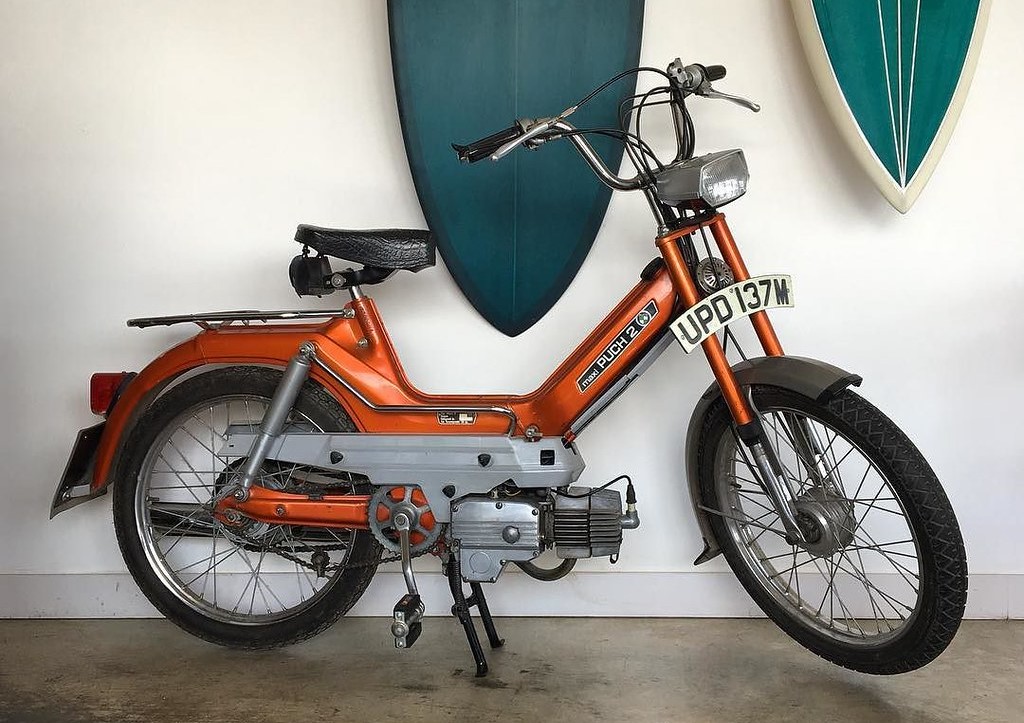The Puch Maxi Moped: A Timeless Icon in Moped History
The Puch Maxi moped, developed by Austrian manufacturer Puch, is a timeless icon in moped history. It was introduced in 1969 and continued production until 1995, becoming popular for its durability and efficiency. The Maxi had various models, each with unique features, catering to different rider preferences and budgets. It played a significant role in the cultural revolution of the 1970s and 1980s, and despite being discontinued, it remains a cherished classic in the modern era.
TWO STROKE1970'SCLASSIC MOPEDSAUSTRIA PUCH
12/24/20233 min read


The Puch Maxi Moped: A Timeless Icon in Moped History
Introduction:
The Puch Maxi moped stands as a quintessential emblem of two-wheeled history, captivating moped enthusiasts with its simplicity, reliability, and charming aesthetic. Developed by the Austrian manufacturing giant Puch, the Maxi series not only brought mobility to the masses but also forged a culture of moped aficionados that endures to this day.
History and Development:
The Puch Maxi's story began in the late 1960s, against a backdrop of social transformation and an increasing demand for affordable personal transport. Austrian manufacturer Puch, renowned for their motorcycles, introduced the Maxi moped in 1969. The Maxi's production continued until 1995, soaring in popularity with over 1.8 million units produced. The Maxi moped became synonymous with durability and efficiency, propelling Puch to the forefront of urban mobility solutions.
Major Models:
The Puch Maxi's lineage comprises a constellation of models, each with unique characteristics catering to diverse rider preferences and budgets. From the comfort and performance blend of the Maxi S to the stretched seating area of the 'D' and 'LS' variants, and the enhanced standard Maxi Luxe, the article explores the distinct features that set each model apart. Special editions like the Maxi Nostalgia and limited-run Maxi BMX Special add layers to the Maxi's cultural significance.
Maxi S: Puch introduced the Maxi S as a full-fledged package of comfort and performance. Featuring full suspension and a robust single-speed E50 engine, the model was a blend of maneuverability and simplicity.
Maxi D or LS: Building on the practical design of the Maxi S, the 'D' and 'LS' variants offered a stretched seating area, enabling the accommodation of a passenger, making it a more social ride.
Maxi Luxe: Positioned as an enhanced standard Maxi, the Luxe came with a Hi-Torque head and stock mudflaps, delineating it as a more premium option.
Maxi N: Known colloquially as the "Poor man's Maxi," this model stripped back to essentials with a rigid frame and lacking a speedometer; it was the budget-friendly gateway to the Maxi world.
Maxi Sport MKII: A sports iteration of the lineage, the MKII boasted upgraded features such as mag wheels, a two-speed ZA50 engine, and an extended seat—though not quite for additional passengers like the Maxi D or LS.
Maxi Nostalgia: A nod to the bygone era, the 1976-exclusive Nostalgia model flaunted a black and gold palette with decals mimicking Puch's historic motorcycle logo.
Newport Line: The Newports were akin to the Maxi S but distinguished by different decals, hand pinstriping, and occasionally a brown saddle. Models like the Newport Auto-start/Oil Inject brought advancements like oil injection and self-start features, while the Newport II upgraded to the ZA50 two-speed engine.
Technical Specifications:
A cornerstone of the Puch Maxi's allure is its technical specificity, providing a robust yet accessible experience for riders. The 49 cc two-stroke engine, offered in various horsepower ratings, governs speed caps, adhering to different moped laws across regions. The step-through frame and various engine configurations (E50 one speed and ZA50 two speed) establish the Maxi as a versatile and reliable mode of transportation.
Cultural Impact:
The Puch Maxi did more than traverse the streets; it became a symbol of freedom and self-expression during a cultural revolution. The 1970s and 1980s saw a surge in moped use, facilitating the birth of a distinct moped culture revolving around customization, group rides, and the emergence of clubs. The Maxi's status as a cultural icon is celebrated by the moped army, a collective of enthusiasts, with restorations, modifications, and events that gather a diverse community of riders and admirers.
The Puch Maxi in Contemporary Times:
Despite ceasing production over two decades ago, the Puch Maxi has thrived as a cherished classic in the modern era. With a growing trend towards sustainable and authentic experiences, mopeds like the Maxi offer an eco-friendly and nostalgically rich alternative to modern vehicles. Enthusiasts worldwide restore and customize these mopeds, breathing new life into them and ensuring the Maxi legacy rolls on through the streets of the 21st century.
Conclusion:
In the grand tapestry of motorcycling history, the Puch Maxi stands out as not just a moped but as a cultural phenomenon—a touchstone of practical engineering, community, and nostalgia. Embodying the spirit of its time, the Maxi transcended its role as a means of transportation, becoming a beloved member of family garages and the muse for collectors and customizers. Its legacy is a testament to the enduring appeal of simplicity and the timeless pursuit of open roads. The Puch Maxi, with its array of models catering to a spectrum of riders, continues to ride through history, leaving behind a trail of joyful memories and a vibrant community that keeps the Maxi spirit very much alive.
